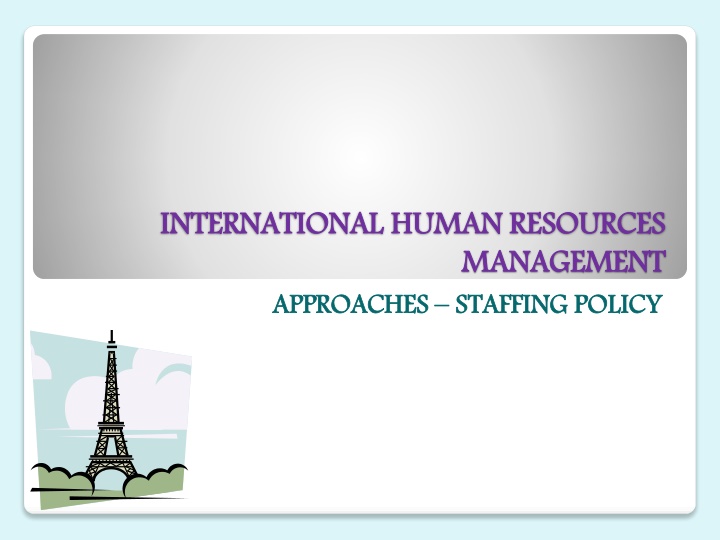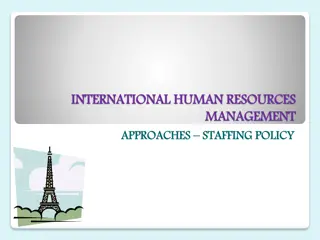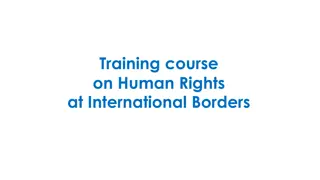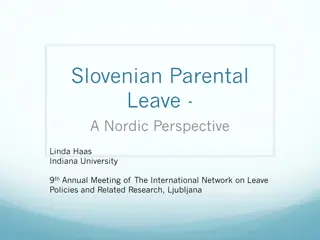International Human Resources Management Approaches and Policies
International Human Resources Management (IHRM) involves selecting employees based on skills and cultural fit. Staffing policies in international firms rely on recruitment practices, government constraints, and attracting suitable candidates. Types of employees include Parent Country Nationals, Host Country Nationals, and Third Country Nationals. Approaches to IHRM include Ethnocentric, Polycentric, Geocentric, and Regiocentric models. Ethnocentric organizations typically fill key positions with Home Country Nationals.
Uploaded on Sep 13, 2024 | 2 Views
Download Presentation

Please find below an Image/Link to download the presentation.
The content on the website is provided AS IS for your information and personal use only. It may not be sold, licensed, or shared on other websites without obtaining consent from the author.If you encounter any issues during the download, it is possible that the publisher has removed the file from their server.
You are allowed to download the files provided on this website for personal or commercial use, subject to the condition that they are used lawfully. All files are the property of their respective owners.
The content on the website is provided AS IS for your information and personal use only. It may not be sold, licensed, or shared on other websites without obtaining consent from the author.
E N D
Presentation Transcript
INTERNATIONAL HUMAN RESOURCES INTERNATIONAL HUMAN RESOURCES MANAGEMENT STAFFING POLICY MANAGEMENT APPROACHES APPROACHES STAFFING POLICY
Hr manager at international level must not only select people with skills but also employees who can mix with the organisation s culture. Recruitment and selection practices in an international firm depend on its staffing policy , host government s constraints on hiring policies and the firms ability to attract candidates. Any organisation need to hire employees, whose style, beliefs and value system are consistent with those of the firm. Introduction
Parent Country National or Home Country National Permanent resident of the country where the firm is headquartered. Host Country National Permanent resident of the country where the operations of the company are located. Third Country National Permanent Resident of a country other than the parent country and the host country. Types of Employees
Expatriate A parent country national sent on a long term assignment to the host country operations. Inpatriate A host country national or a third country national assigned to the parent country where the company is headquartered. Repatriate An expatriate coming back to the home country at the end of a foreign assignment. Types-Contn
ETHNOCENTRIC POLYCENTRIC GEOCENTRIC REGIOCENTRIC Four Approaches to IHRM Four Approaches to IHRM
ETHNOCENTRIC The ethnocentric approach places natives of the home country of a business in key positions at home and abroad. In this example, the U.S. parent company places natives from the United States in key positions in both the United States and Mexico.
Motto : this work in my country therefore, it must work in other countries also Home Country Oriented Organization All key positions are filled with the HCNs. Common for MNCs in the early stages of Internalization. HCN,s are developed to work anywhere ENTHNOCENTRIC ORGANISATIONS ENTHNOCENTRIC ORGANISATIONS
Quite expensive to employ expatriates in foreign subsidiaries For many expatriates a key international position means new status, authority and an increase in standard of living. These changes may affect expatriates sensitivity to needs and expectations of their host country subordinates. Language, cultural differences exist. Disadvantages Disadvantages Contn Contn
Lack of qualified host country managers or Perception that they may not be available. Desire to maintain a unified corporate culture and tight control. Desire to transfer quickly the firm s core competencies to foreign subsidiaries. To ensure that coordination and communication are maintain adequately in headquarters. Reasons Reasons
When a Korean Company (Samsung, LG, Hyundai) invests in Chennai, India is the Host Country and Korea is the Home Country (Guest). If the Korean Company is ethnocentric it will appoint the Home or Parent Country nationals at head positions. Firms such as P&G, Phillips, Samsung originally followed the ethnocentric approach. Example: Example:
May lead to reduced productivity and high turnover due to limited promotion opportunities for host country nationals. The parent company nationals may take a lot of time in understanding the host country culture leading to faulty decisions. Since the compensation paid to parent company nationals is greater, host country nationals may feel discriminated and frustrated Disadvantages Disadvantages
This approach is reflected in Staffing policy Performance appraisal New product development Evaluation of all the above designed and administered by Parent Country nationals. Contn Contn
POLYCENTRIC In this example, the Australian parent company uses natives of India to manage operations at the Indian subsidiary. Natives of Australia manage the home office. Top Indian IT companies like TATA, HCL technologies India's fourth largest software export, Infosys and Wipro stepped in United States to set up their subsidiaries and recruited American nationals from colleges and experienced professionals who had the local knowledge and domain expertise
The motto is When in Rome do as the Romans do It means when you are elsewhere live as they live elsewhere. The Polycentric Staffing requires host country nationals to be hired to manage subsidiaries, while parent-country nationals occupy key positions at corporate headquarters. POLYCENTRIC ORGANISATIONS POLYCENTRIC ORGANISATIONS
The Polycentric Message is Local People know what is best for them. Let s give them some money and leave them alone as long as they make us a profit . Government Pressure and Foreign Laws often necessitate polycentric approach. Many multinationals adopt this approach because they face the heterogeneous environments. Product Preferences may be the deciding factors and strategies are to be developed on a market by market basis. Introduction Introduction
Less Expensive Local managers can handle easily local dynamics. No Language and cultural Barriers. Local politics and administration can be managed easily. Though high salary need be given to Host Country Nationals, it is still less than paying PCNs Turnover Reduced Advantages Advantages
Bridging the Gap between HCN subsidiary. Managers and the PCNs at Headquarters face problems with regard to Language barriers conflicting national loyalties differences emanating from personal values, attitudes to business etc. Parent Company Nationals do not get exposure and experiences to foreign jobs. This may restrict their career growth . DisAdvantages DisAdvantages
GEOCENTRIC The geocentric approach uses Ihe best available managers for a business without regard for their country of origin. In this example, the UK parent company uses natives of many countries at company headquarters and at the U.S. subsidiary.
MottoRight Person For the Right Job This Staffing Philosophy seeks the best people for key jobs throughout the organisation, regardless of the nationality. The MNC takes a Global Approach to its operation. It follows worldwide integrated business. GEOCENTRIC ORGANISATIONS GEOCENTRIC ORGANISATIONS
It enables a multinational firm to develop an international executive team which assists in developing a global perspective. It develops an internal pool of labour for deployment throughout the global organisation. It helps in building a stronger and more consistent culture among the entire global management team. It has a continuous interaction and networking among the team members. Advantages Advantages
Greater Paperwork is involved in hiring foreign nationals. Hassles of obtaining work permit for dependents of the employee. Training,relocation and compensation costs of foreign nationals are higher. The employment policy of a foreign country may be a constraint. Bridging the Gap between with regard to language barriers, conflicts on national loyalties, personal values, culture is difficult and time consuming. DISAdvantages DISAdvantages
REGIOCENTRIC The regiocentric approach places managers from various countries within geographic regions of a business. In this example, the U.S. parent company uses natives of the United States at company headquarters. Natives of European countries are used to manage the Italian subsidiary.
Regionally oriented organizations. A corporation implements a regional strategy when synergistic benefits can be obtained by sharing functions across regions. The operations of the global firm are divided into a few geographical regions. The international staff is transferred within the same region they work. Eg. Europe, America, Asia-Pacific etc. REGIOCENTRIC ORGANISATIONS REGIOCENTRIC ORGANISATIONS
Regional Headquarter organizes collaborative efforts among local subsidiaries, responsible for the regional plan, local research and development, local executive selection and training, product innovation, cash management, brand policy, capital expenditure and public relations. The Headquarter managers take care of world strategy, country analysis basic research and development, foreign exchange, transfer pricing, technology transfer, inter company loans etc. Introduction Introduction
It allows interaction between executives transferred to regional headquarters from subsidiaries in the region and PCNs, posted to regional headquarters. It facilitates shift from a purely ethnocentric approach to geocentric approach. It reflects some sensitivity to local conditions, since local subsidiaries are staffed almost totally by HCNs. Advantages Advantages
There may be Federalism at regional rather than on country basis Career prospects at regional level are hampered DISAdvantages DISAdvantages
REFERENCES: - Human Resource Management C.B.Gupta - Articlebase from Internet: Approaches To International Human Resource Management Dr.Shanmukha Rao Padala & Dr.N.V.S. Suryanarayana. - www.whatishumanresource.com/international- recruitment THANK YOU THANK YOU ANNIE JANE ANNIE JANE 13PHR131 13PHR131























